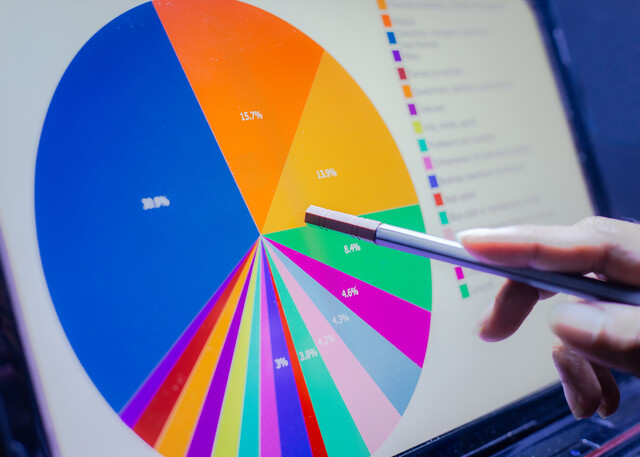In this article, you will learn how to measure brand equity, and how measurements are important to the management of brand equity.
Let's begin with McDonald's, one of the most well-known brands in the world. Immediately recognizable, it is a worldwide brand that serves millions of meals each day. But how do McDonald's marketers know how well the brand is performing?
The marketing department does various types of market research to determine how well a brand is performing. This can take many forms. A popular form of market research is focus groups. It allows a marketer to talk directly to actual consumers, and ask them specific questions. Another popular form is research surveys. Since a marketer can reach more consumers, it is a way to track brand equity among a larger sample audience.
Think!
Have you ever participated in a focus group? What types of questions do you think would be asked in a focus group?
Have you ever completed a company survey? What types of questions did it ask about the brand?
Research must be done with existing customers to gauge consumer loyalty, but also with former customers. Why did the former customers leave the brand? How does this affect brand equity? How can these measurements help the brand gain new customers?
There are three main methods used when determining financial research:
1. Financial Brand Equity Metrics
2. Strength Brand Equity Metrics
3. Consumer Brand Equity Metrics
1. Financial Brand Equity Metrics
Financial metrics are often seen as the most important aspect of brand research. After all, how a brand is performing financially, is essential to profits. However, financial metrics should be the last step when determining whether a brand is profitable or not.
Think about it. Financial research and its results are tied to the strength of the brand, as well as how consumers respond to the brand. If McDonald's does financial research and determines sales are decreasing, that information is useless without knowing why sales are decreasing.
That said, when gathering financial brand equity metrics, the following data must be collected:
-
Market share
-
Cost of retaining current customers
-
Cost of gaining new customers
-
Revenues
-
Profitability
-
Growth Rate
The marketing department will look at the above data to spot trends, whether positive or negative, and use that data to build brand equity. Financial data can help determine whether the brand is an asset for the company, and whether the brand's reach can be increased.
Think!
If a brand's market share is decreasing, what could be the possible cause?
If the cost of retaining existing customers is increasing, what could be the possible cause?
Let's go back to McDonald's.
McDonald's is famous for many things, one of which is their breakfasts. The Egg McMuffin is probably the most well-known breakfast sandwich in the world. They are also known for their "big breakfast," -- a platter of hotcakes, eggs, sausage, biscuit and hash browns.
They are also famous for ending their breakfast at 10:30 a.m., when every other fast food restaurant serves breakfast all day.
So McDonald's does market research to determine whether serving breakfast all day would be a financially wise decision, and whether the move would improve the brand's equity.
They start offering breakfast all day, but only in a few markets. In this case, they chose San Diego, Tennessee, and Mississippi as their test markets. Just the announcement of the test in limited markets was enough to get the brand buzzing. Just the possibility of all-day breakfast made consumers excited.
The results confirm what their customers were telling them -- that if McDonald's sells breakfast all day, customers will buy.
Think!
McDonald's is known for their breakfasts, and limited-time-only items, such as the McRib and their Shamrock Shake.
Can you think of other brands that use the same limited-time-only strategy?
2. Strength Brand Equity Metrics
The strength and power of a brand is an essential part of brand equity. McDonald's is a perfect example of a brand that is able to survive through changing markets and customers. The company and brand is 65 years old, and yet, remains a popular brand with brand recognition that continues to increase.
When gathering strength brand equity metrics, the following data must be collected:
-
Brand awareness
-
Brand recognition
-
Brand loyalty
-
How accessible is the brand
-
Is the brand retaining customers?
-
Is the brand able to license itself?
-
Is the brand developing buzz?
With the advent of social media, marketers are able to measure how well the brand is performing very quickly. Social media metrics, such as reach and engagement, can be used in coordination with financial metrics to help support positive brand equity.
Think!
Have you ever engaged with a brand on social media?
What was the intent of the engagement?
Did the brand respond, and if so, were you satisfied with their response?
When McDonald's announced it was testing whether they should offer breakfast all day, social media went wild. McDonald's breakfasts was trending on Twitter and Facebook, which gave immediate data to the marketing team.
3. Consumer Brand Equity Metrics
You cannot have a brand without the consumer. How the consumer feels about the brand is the single most important aspect when building brand equity.
Therefore, a company must measure how consumers are responding to the brand. If consumers are positive about a brand, it increases brand equity, and if they are negative, it will result in a decrease of brand equity. It also gives insight into why brand equity is at its current level.
When gathering consumer brand equity metrics, the following data must be collected:
-
How relevant is the brand?
-
Do consumers have an emotional connection to the brand?
-
What is different about the brand, compared to its competitors?
-
Does the brand offer a good value to its consumers?
-
What perceptions do consumers have about the brand?
This form of market research is the most difficult as it requires the marketer to get into the head of the consumer.
Think!
Are you completely loyal to any brands?
Why?
What would the brand have to do to lose you as a customer?
This type of research has to be done directly with the consumer, whether one on one, in focus groups, or large surveys. When gaining consumer data for all-day breakfasts, McDonald's might ask the following questions:
1. When you hear the name "McDonald's," how does it make you feel?
2. How is McDonald's different from other fast food restaurants, such as Burger King, Jack in the Box, or Carl's Jr.?
3. Are the prices of McDonald's breakfasts affordable?
When focus groups are used, consumers sit at a table and are asked to use the product, and respond accordingly. In addition, the brand manager is often able to watch the focus group when the brand representatives are not in the room. This gives the marketing team an opportunity to find out what consumers think about the brand when they don't think the brand managers are listening.
These three forms of measurements provide a marketing team with all the data needed to determine whether or not a brand has positive or negative brand equity, and provides the information needed to make any necessary changes.
Managing Brand Equity
Once the marketing team measures the strength of brand equity, it is time to manage that brand equity. What does this entail? It requires the company to find a way to shape how the consumer feels about the brand. It requires the company to build the brand so consumers will have positive feelings and perceptions of the brand.
Remember what brand equity is. "Brand Equity" is defined as the value of a brand, based on consumer loyalty and positive brand characteristics. The more brand equity a company has, the more sales it will make, and the more consumer loyalty it will gain. It is the job of the marketer to use strategies to increase brand equity.
If a company has strong brand equity, customers will consume and purchase more. If the customer has a positive opinion of the brand, they will recommend the brand to friends and family. If the customer has a good perception of the brand, they will become loyal, and less likely to purchase from competing brands.
So, what do companies do when building and managing brand equity? They use the following four-step process:
1. Brand Identity – Does the consumer know the brand exists?
2. Brand Meaning – What does the brand mean to you?
3. Brand Response – How does the brand make you feel?
4. Brand Resonance – Do you have an emotional connection to the brand?
As you can see, without the first step, you cannot reach the second step. Without the second step, you cannot reach the third step, etc.
1. Brand Identity – Does the consumer know the brand exists?
This step requires a company to gain awareness for its brand. In addition, it requires the company to make sure consumers' perceptions of the brand are correct, and in line with what the company expects.
2. Brand Meaning – What does the brand mean to you?
This step requires a company to determine what a brand means to a consumer, and what consumers think of when they hear the brand name.
McDonald's would want to know the following:
Is the quality of food consistent?
Does McDonald's have good customer service?
Are McDonald's prices a good value?
Are McDonald's restaurants clean and modern?
3. Brand Response – How does the brand make you feel?
This step requires a company to determine how a brand makes the consumer feel. Do they have good feelings about the brand or bad feelings? McDonald's would want to know the following:
Does the name McDonald's make you feel good or bad?
Do you trust the McDonald's brand?
Would you recommend McDonald's to a friend or family member?
Is there anything McDonald's can do to better meet your needs?
Do you prefer McDonald's to other comparable restaurants?
What brands have you recommended to friends or family members?
If that friend had a negative experience, would you feel responsible?
4. Brand Resonance – Do you have an emotional connection to the brand?
This final step determines whether the consumer has an emotional bond to the brand. McDonald's would want to know the following:
How often do you eat at McDonald's?
When taking your family to McDonald's, is it considered a special treat or event?
Do you feel like a member of the McDonald's family or community?
When McDonald's holds special events, such as their Monopoly game, do you participate?
Have you ever posted on McDonald's social media sites?
A good example of brand resonance is store loyalty cards. If a loyalty card tracks all customer purchases, and gives rewards for amount of money spent, a consumer is more likely to shop in that store. Most supermarkets have these loyalty cards, as it is a relatively easy way to gain consumer loyalty.
Another example would be Starbucks. The Starbucks reward card gives points for purchases of food and coffee drinks. Once a consumer receives a certain number of stars, they are entitled to a free drink or food item. In addition, Starbucks gives free rewards for customer birthdays.
Think!
Are there any brands that give you an immediate positive response? Why?
Are there any brands that give you an immediate negative response? Why?
For example, many people ate McDonald's Happy Meals as a child. Would this cause a positive or negative response?
So, what did you learn in this article?
1. You learned how companies collect data to determine level of brand equity.
2. You learned the three types of data collected, financial, strength, and consumer.
3. You learned how companies manage brand equity.
4. You learned the four steps necessary when managing brand equity.
Building Brand Equity and Selecting Brand Elements
In this article, you will learn how companies build brand equity, and how they select the brand elements used in their logos, packaging, and advertisements.
You now can confidently say that you understand what brand equity is, and why it is important for a brand to have it. The more brand equity a company has, the more sales it will make, and the more consumer loyalty it will gain.
But how does a company build brand equity so that it becomes a valuable asset for the company?
Whether a company is launching a new brand, or extending an existing brand, brand equity must be continually monitored.
1. Brand Awareness
2. Brand Recognition
3. Brand Experience
4. Brand Preference
5. Brand Loyalty
It is the responsibility of the brand's marketing team to make sure consumers are moving though each of the five steps above. As you have learned, it is the consumer that builds the brand, not the company.
To keep consumers moving through the steps, the brand must consider the following factors:
-
Differentiation
-
Value
-
Performance
-
Emotional Connection
-
Engagement
Differentiation:
Differentiation is how a brand is unique and different than other brands in the same category. A brand must be able to explain why the brand is relevant to the consumer, and why other brands are not. Brand positioning is an important part of this step, and key in building brand equity.
For example, the two largest computer companies in the world are Apple and Microsoft. How would one differentiate itself from the other?
Think!
Apple and Microsoft are two totally distinct computer companies.
If you worked for Microsoft, how would you differentiate your brand?
Another example is Coca-Cola and PepsiCo. These two companies are the largest soft drink companies in the world, and most people have a preference. Now, this preference is often due to taste, even though the two drinks are extremely similar.
Since Coca-Cola has the larger market share (it is almost 2-1), the onus is on Pepsi to find a way to stick out. For a long time, Pepsi positioned itself for younger soda drinkers, using the slogan, "The choice of a new generation." However, Pepsi has never been able to close the gap between Coke and itself. Much of this is due to the brand equity of Coca-Cola.
Value:
Value is pretty obvious. A consumer must feel a brand provides a good value in order for them to purchase it. Eventually, if brand loyalty is achieved, brand value isn't as important, as a loyal consumer will continue to use a brand even if it is more costly that other brands.
Think!
What type of products do you buy based on price alone?
Are there any brands that you are willing to pay a premium for? What is it about the brand that has gained your loyalty?
Performance:
Consumers must feel confident that a brand will perform as promised in order to move up the steps. For example, if a new laundry detergent brand is introduced to the market, and it promises to remove stains using a very small amount of the detergent, the brand better be able to perform as promised. Otherwise, the consumer will have a negative perception of the brand, and will not purchase it again, even if the price is lowered.
Having a good record of performance can help a brand through any problems it may face.
For example, FedEx is a well-known brand that offers overnight and expedited shipping. FedEx is a great example of a brand that keeps its promises, and almost always delivers as promised.
However, bad things do happen. Bad weather conditions can affect whether planes are able to fly, and holiday seasons are often so busy some shipments are delivered later than promised.
But because FedEx is a brand that has an excellent performance record, consumers are more willing to understand when problems occur. This type of loyalty is invaluable to a brand, and having consistent performance is key to building brand loyalty.
Emotional Connection:
Capturing an emotional connection is the Holy Grail of brand equity. It is the best way to build and maintain consumer loyalty. To gain this loyalty, a brand must gain the trust of the consumer, and keep all promises given through the five steps of brand equity.
An emotional connection means that a consumer is able to depend on a brand. For example, if a consumer can always trust Tide detergent, they will continue to purchase that product, and depend on it to perform as promised. It is similar to how consumers build connections with friends -- over time.
Think!
What products do you trust the most?
What brands can you always depend on?
Engagement:
When consumers as a whole enjoy using a brand, that brand can become a true cult brand, which is the ultimate form of customer loyalty.
Apple is the perfect example. No other brand has such a loyal customer base as Apple. Every year when Apple releases a new version of the iPhone, consumers line up to purchase the phone, even if their current phone is operating perfectly.
Harley-Davidson is another good example. Owners of Harley-Davidson motorcycles often join groups of other owners, and form a bond over the product and brand. This emotional relationship keeps the consumer loyal to the brand, and therefore, builds brand equity.
Gaining this level of engagement can be difficult, but it is possible. Using social media is a great way for brands to position themselves as a brand worthy of a cult following.
Building and maintaining brand equity is an ongoing process that never ends. Measuring brand equity will keep an eye on whether brand equity is increasing or decreasing, and is a way to spot trends before they can cause any real damage to the brand.
Selecting Brand Elements
When a company is building brand equity, it uses many different strategies to reach and meet its goals. One of these strategies is brand name, logo, packaging, and advertising. Basically, how a brand looks to the consumer.
So, where does a brand begin?
There are many elements that go into defining the way a brand looks to the consumer.
1. Business Name
2. Logos
3. Colors
4. Slogan or Tagline
5. Font
6. Resonance
7. Sounds
8. Smells
Business Name:
The name of a brand goes a long way with the consumer. A brand must be able to ask itself:
Is the name distinctive? Does it stand out and sound different from competitors?
Is the name short and easy to remember? A short name is easier to remember than a long one.
Does the name work well with the brand it is representing?
Is the name easy to spell and pronounce?
Is the name likable? Would a consumer enjoy saying it?
Can the name be used legally? Can the name be trademarked? You don't want to find a great name to only find out someone else owns the trademark.
Logo:
Developing the logo is second to the name when branding a product. Large companies will hire professional designers to design a logo. This process often begins with preliminary sketches. The designers must make sure that the logo represents the brand perfectly.
Colors:
Many brands can be recognized based on their colors alone.
If I said, what laundry detergent has orange packaging, what you say? If you said Tide, you are correct!
If I said, what jewelry company uses robin egg blue boxes with white ribbons? If you said Tiffany's, you are correct!
If I said what national chain store uses a logo that is a bright red bull's-eye? If you said Target, you are correct!
While colors are extremely important and effective, they can also work against a brand. Using colors that are too bright can be off-putting to some consumers, and lack of color can also be off-putting. When deciding how much color to use, and which colors, the most successful brands have used only one or two colors, and those colors are usually primary colors, such as red, blue and yellow.
Developing a signature color is incredibly successful, and must be done as early as possible, as changing it in the future will be difficult.
Slogan or Tagline:
Having a slogan or tagline is one of the easiest ways to become a brand consumers can remember. Like colors, a brand can often be recognized using the slogan alone.
What are the most effective slogans of all time? Take a look and see how many you remember.
"Hey, Mikey -- he likes it!" – Life Cereal
"Don't leave home without it." – American Express
"A diamond is forever." – DeBeers
"They're g-r-r-r-eat!" – Frosted Flakes
"Rice-A-Roni, the San Francisco treat." – Rice-A-Roni
"The best part of waking up is Folgers in your cup." – Folger's Coffee
Think!
Name the first three brand slogans that come to your mind.
How old are the slogans? Can you describe what makes them timeless?
Fonts:
Using a unique font, or designing a new font, is a great way to gain brand visibility. For example, here are some brands that use unique fonts, and are memorable due to these fonts:
Coca-Cola
Disney
IBM
Skype
Hulu
Resonance:
Resonance is the tone used for the voice of your business. If you are a professional service, your tone will probably be of serious and sincere. If you are a cosmetic company that targets young women, your tone might be fun and down-to-earth. This tone should be used in all verbal and written materials.
Brands often use celebrities to bring a certain tone to their product, and this is often very successful. Think of the following brands and spokespeople:
CNN – James Earl Jones
Budweiser – George Clooney
Nationwide Insurance – Julia Roberts
American Airlines – Jon Hamm
Dunkin' Donuts – John Goodman
Ram Trucks – Sam Elliot
Sounds:
Sounds and music can also define a brand. Think of the jingle for State Farm, or McDonald's, or Kit-Kat candy bars.
Sounds can also be defining. Think of the NBC chimes, or the dun-dun of the Law & Order television franchise.
Think!
What are your favorite brand jingles? What about them makes them so likable to you?
Can you think of any jingles that you absolutely hate? What is it about the jingle that you find annoying?
Obviously most brands do not have to concern themselves with smells. But for products that do, the way a brand smells can make or break the brand.
You often hear that when you are trying to sell a house, you should bake cookies during the open house. This is because the smell of baked goods makes someone feel at home.
Think of how the new-car smell makes you feel.
Think of products that have a distinctive smell.
Johnson's Baby Shampoo and Baby Oil
Vicks VapoRub
Ivory soap
Juicy Fruit gum
These scents affect the sensory areas of the brain, and help the consumer identify a brand easier. Many stores use scents to appeal to the customer's senses. Think of stores like Victoria's Secret or Bath & Body Works.
What scents and smells give you the best memories?
Are there any scents that bring back bad memories?
The above eight elements are the main considerations when branding a product. There are other, smaller elements, but these eight are the ones designers use when designing the perfect look for a brand.
So, what did you learn in this lesson?
1. You learned how companies use differentiation, value, and performance to increase brand equity.
2. You learned how brand engagement could lead to a cult-like following for the brand.
3. You learned the eight elements that go into the design of a product's brand.
4. You learned how scents and sounds could lead to an emotional attachment to a brand.





























